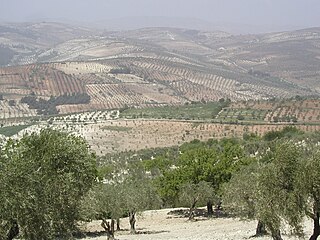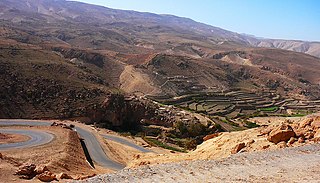
Kurmanji, also termed Northern Kurdish, is the northernmost of the Kurdish languages, spoken predominantly in southeast Turkey, northwest and northeast Iran, northern Iraq, northern Syria and the Caucasus and Khorasan regions. It is the most widely spoken form of Kurdish.

Sinjar is a town in the Sinjar District of the Nineveh Governorate in northern Iraq. It is located about five kilometers south of the Sinjar Mountains. Its population in 2013 was estimated at 88,023, and is predominantly Yazidi.

Kurd Mountain or Kurd Dagh is a highland region in northwestern Syria and southeastern Turkey. It is located in the Aleppo Governorate of Syria and Kilis Province of Turkey. The Kurd Mountain should not be confused with the neighboring Jabal al Akrad, which is located further southwest in Latakia Governorate.

Yazidis in Armenia are Yazidis who live in Armenia, where they form the largest ethnic minority. Yazidis settled in the territory of modern-day Armenia mainly in the 19th and early 20th centuries, fleeing religious persecution by the Ottoman Empire and Sunni Kurds. While Yazidis were counted as Kurds in censuses for much of the Soviet period, they are currently recognized as a separate ethnic group in Armenia. According to the 2011 census, around 35,000 Yazidis live in Armenia.

Afrin District is a district of Aleppo Governorate in northern Syria. The administrative centre is the city of Afrin. At the 2004 census, the district had a population of 172,095. Syria's Afrin District fell under the control of the People's Protection Units (YPG) around 2012 and an "Afrin Canton" was declared in 2014, followed by an "Afrin Region" in 2017. During Operation Olive Branch, the entire district was captured by Turkey and its allies.

Yazidis or Yezidis are a Kurdish-speaking endogamous religious group who are indigenous to Kurdistan, a geographical region in Western Asia that includes parts of Iraq, Syria, Turkey and Iran. The majority of Yazidis remaining in the Middle East today live in Iraq, primarily in the governorates of Nineveh and Duhok.

The Sinjar Mountains, are a 100-kilometre-long (62 mi) mountain range that runs east to west, rising above the surrounding alluvial steppe plains in northwestern Iraq to an elevation of 1,463 meters (4,800 ft). The highest segment of these mountains, about 75 km (47 mi) long, lies in the Nineveh Governorate. The western and lower segment of these mountains lies in Syria and is about 25 km (16 mi) long. The city of Sinjar is just south of the range. These mountains are regarded as sacred by the Yazidis.

Bashiqa is a town situated at the heart of the Nineveh plain, between Mosul and Sheikhan, on the edges of Mount Maqlub.

The Sinjar District or the Shingal District is a district of the Nineveh Governorate. The district seat is the town of Sinjar. The district has two subdistricts, al-Shemal and al-Qayrawan. The district is one of two major population centers for Yazidis, the other being Shekhan District.

The Autonomous Administration of North and East Syria (AANES), also known as Rojava, is a de facto autonomous region in northeastern Syria. It consists of self-governing sub-regions in the areas of Afrin, Jazira, Euphrates, Raqqa, Tabqa, Manbij, and Deir Ez-Zor. The region gained its de facto autonomy in 2012 in the context of the ongoing Rojava conflict and the wider Syrian civil war, in which its official military force, the Syrian Democratic Forces (SDF), has taken part.

The Women's Protection Units or Women's Defense Units is an all-female militia involved in the Syrian civil war. The YPJ is part of the Syrian Democratic Forces, the armed forces of Rojava, and is closely affiliated with the male-led YPG. While the YPJ is mainly made up of Kurds, it also includes women from other ethnic groups in Northern Syria.

Syrian Kurdistan is a region in northern Syria where Kurds form the majority. It is surrounding three noncontiguous enclaves along the Turkish and Iraqi borders: Afrin in the northwest, Kobani in the north, and Jazira in the northeast. Syrian Kurdistan is often called Western Kurdistan or Rojava, one of the four "Lesser Kurdistans" that comprise "Greater Kurdistan", alongside Iranian Kurdistan, Turkish Kurdistan, and Iraqi Kurdistan.

The Ezidkhan Command for Liberating Sinjar, known as the Sinjar Alliance, is a joint command of two - initially three - Yazidi militias, the Sinjar Resistance Units (YBŞ), and the Êzîdxan Women's Units (YJÊ). Both of the remaining two militias are supported by the Kurdistan Workers' Party (PKK).

A genocide of Yazidis by the Islamic State was carried out in the Sinjar area of northern Iraq in the mid-2010s. The genocide led to the expulsion, flight and effective exile of the Yazidis. Thousands of Yazidi women and girls were forced into sexual slavery by ISIL, and thousands of Yazidi men were killed. About 5,000 Yazidi civilians were killed during what has been called a "forced conversion campaign" carried out by ISIL in Northern Iraq. The genocide began after the withdrawal of Iraqi forces and Peshmerga, which left the Yazidis defenseless.

The Sultan Murad Division is an armed rebel group in the Syrian Civil War, created around a Syrian Turkmen identity. It is aligned with the Syrian opposition and are heavily supported by Turkey, who provides funding and military training along with artillery and aerial support. It is the most notable group among Syrian Turkmen Brigades supported by Turkey.

The Turkish Armed Forces and its ally the Syrian National Army have occupied areas of northern Syria since August 2016, during the Syrian Civil War. Though these areas nominally acknowledge a government affiliated with the Syrian opposition, in practice they constitute a separate proto-state under the dual authority of decentralized native local councils and Turkish military administration.

Afrin Canton was one of the cantons of Rojava. Syria's Afrin District fell under the control of the People's Protection Units (YPG) around 2012 and an "Afrin Canton" was declared in 2014. Afrin Canton in its latest form was established in 2017, however, as part of the reorganisation of Rojava's subdivisions. With Afrin as its administrative centre, the canton was part of the larger Afrin Region. As a result of Operation Olive Branch in early 2018, Afrin Canton became part of the Turkish occupation of northern Syria. The government of the Afrin Region now administers only the area around Tell Rifaat.
Siba Sheikh Khidir is a village located in the Sinjar District of the Ninawa Governorate in Iraq. The village is located south of the Sinjar Mount. It belongs to the disputed territories of Northern Iraq. Siba Sheikh Khidir is populated by Yazidis and was one of two villages targeted in the 2007 Yazidi communities bombings against the local Yazidi community.
The August 15, 2018, Turkish airstrikes on Sinjar were two airstrikes on İsmail Özden, a leading member of the Sinjar Resistance Units (YBŞ). Four others were killed in the airstrike.

The persecution of Yazidis has been ongoing since at least 637 CE. Yazidis are an endogamous and mostly Kurmanji-speaking minority, indigenous to Kurdistan. The Yazidi religion is regarded as "devil-worship" by Muslims and Islamists. Yazidis have been persecuted by the surrounding Muslims since the medieval ages, most notably by Safavids, Ottomans, neighbouring Muslim Arab and Kurdish tribes and principalities. After the 2014 Sinjar massacre of thousands of Yazidis by ISIL, which started the ethnic, cultural, and religious genocide of the Yazidis in Iraq, Yazidis still face discrimination from the Iraqi government and the Kurdistan Regional Government.



















